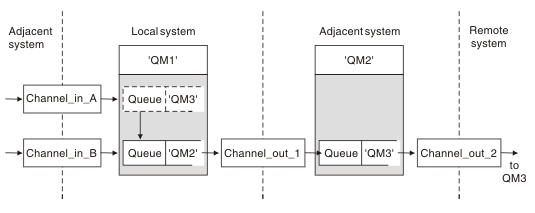Queue manager alias definitions
Queue manager alias definitions apply when an application that opens a queue to put a message, specifies the queue name and the queue manager name.
- When sending messages, remapping the queue manager name
- When sending messages, altering or specifying the transmission queue
- When receiving messages, determining whether the local queue manager is the intended destination for those messages
Outbound messages - remapping the queue manager name
THISQ and a queue manager name of YOURQM. At the local queue manager, there is a queue manager alias definition like the following example:
DEFINE QREMOTE (YOURQM) RQMNAME(REALQM)
This shows that the real queue manager to be used, when an application puts messages to queue manager YOURQM, is REALQM. If the local queue manager is REALQM, it puts the messages to the queue THISQ, which is a local queue. If the local queue manager is not called REALQM, it routes the message to a transmission queue called REALQM. The queue manager changes the transmission header to say REALQM instead of YOURQM.
Outbound messages - altering or specifying the transmission queue
QM1 with transmission headers showing queue names at queue manager QM3. In this scenario, QM3 is reachable by multi-hopping through QM2.
QM3 are captured at QM1 with a queue manager alias. The queue manager alias is named QM3 and contains the definition QM3 through transmission queue QM2. The definition looks like the following example:
DEFINE QREMOTE (QM3) RNAME(' ') RQMNAME(QM3) XMITQ(QM2)
The queue manager puts the messages on transmission queue QM2 but does not alter the transmission queue header because the name of the destination queue manager, QM3, does not alter.
All messages arriving at QM1 and showing a transmission header containing a queue name at QM2 are also put on the QM2 transmission queue. In this way, messages with different destinations are collected onto a common transmission queue to an appropriate adjacent system, for onward transmission to their destinations.
Inbound messages - determining the destination
A receiving MCA opens the queue referenced in the transmission header. If a queue manager alias definition exists with the same name as the queue manager referenced, then the queue manager name received in the transmission header is replaced with the RQMNAME from that definition.
- Directing messages to another queue manager
- Altering the queue manager name to be the same as the local queue manager